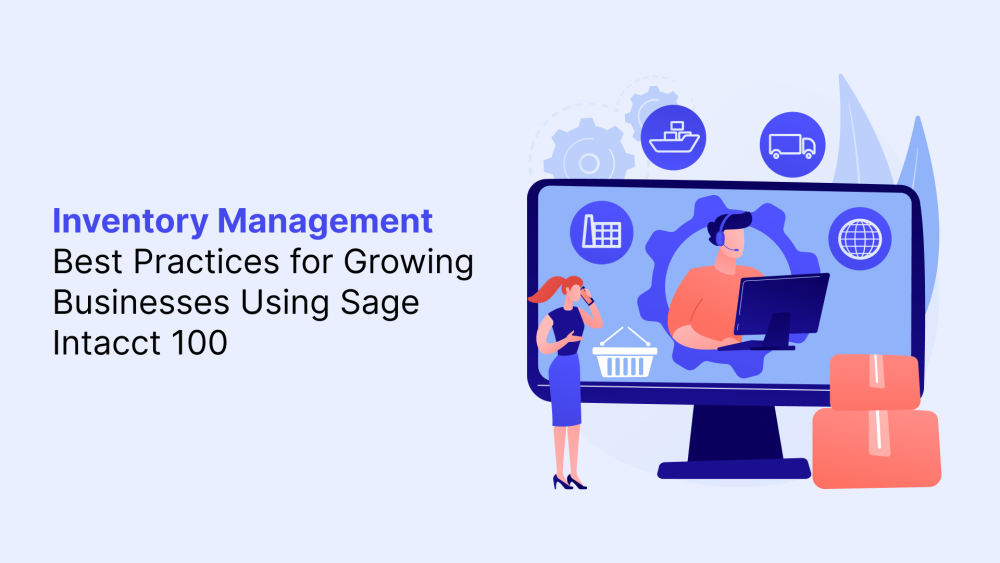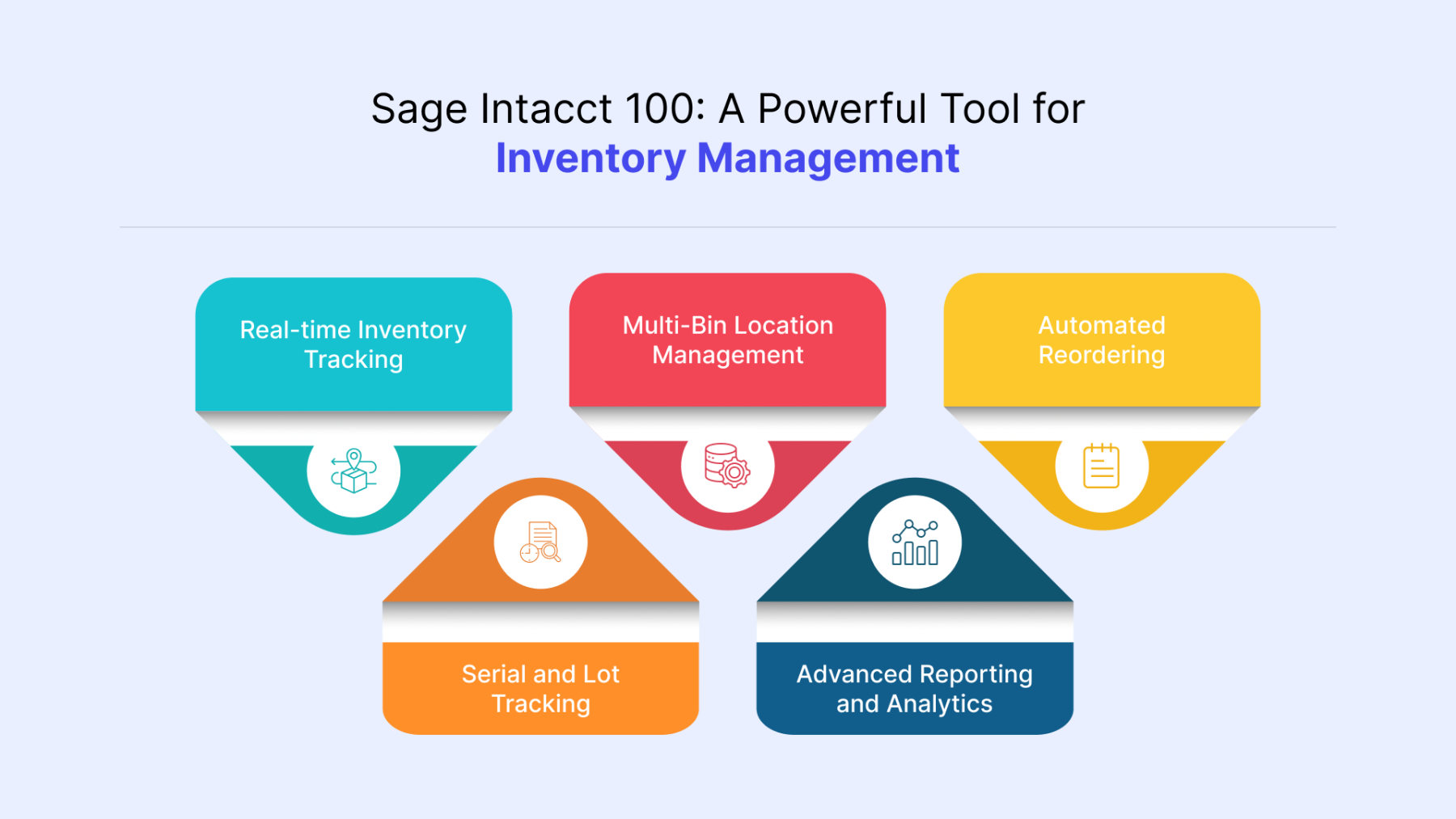Inventory management is a critical function for any growing business. It directly impacts your ability to fulfill customer orders on time, optimize cash flow, and maintain profitability. As your business scales, manual inventory management methods become unwieldy and prone to errors. This is where a robust inventory management system like Sage Intacct 100 comes into play.
This blog dives into essential inventory management best practices for growing businesses, exploring how Sage Intacct 100 can be leveraged to achieve optimal inventory control. We'll cover key functionalities, integration benefits, industry-specific considerations, and the latest tools and technologies to empower your inventory management journey.
Why Strong Inventory Management Matters for Growing Businesses
-
Reduced Stockouts: Inefficient inventory management can lead to stockouts, resulting in lost sales and customer dissatisfaction. A 2021 survey by Aberdeen Group revealed that companies with best-in-class inventory management experience 40% fewer stockouts compared to their peers.
-
Improved Cash Flow: By optimizing inventory levels, you can minimize holding costs associated with excess stock. This frees up cash flow that can be reinvested in other growth initiatives.
-
Enhanced Profitability: Effective inventory management helps prevent write-offs due to obsolescence or damage, leading to improved profit margins.
-
Increased Operational Efficiency: Streamlined inventory processes reduce the time and resources required for inventory tracking and management.
Sage Intacct 100: A Powerful Tool for Inventory Management
Sage Intacct 100 is a cloud-based accounting software solution designed for growing businesses. It offers a comprehensive inventory management module with features like:
-
Real-time Inventory Tracking: Gain real-time visibility into your inventory levels across multiple locations, warehouses, and product variations.
-
Multi-Bin Location Management: Track inventory at the bin level for precise stock control, especially for businesses with high-volume or small-sized items.
-
Automated Reordering: Set reorder points to automatically generate purchase orders when inventory levels dip below a defined threshold.
-
Serial and Lot Tracking: Track individual items or batches for improved quality control and traceability (valuable for industries like food and pharmaceuticals).
-
Advanced Reporting and Analytics: Gain insights into inventory performance through reports on inventory turnover, stockouts, and carrying costs.
These functionalities empower businesses to:
-
Maintain optimal inventory levels: Minimize the risk of stockouts and overstocking by keeping inventory levels aligned with demand forecasts.
-
Reduce inventory carrying costs: By minimizing excess stock, businesses can reduce storage costs, insurance costs, and the risk of obsolescence.
-
Improve order fulfillment efficiency: Real-time inventory visibility ensures accurate order fulfillment and prevents delays due to stock discrepancies.
-
Make data-driven decisions: Leverage reporting and analytics to identify trends, optimize purchasing strategies, and make informed inventory management decisions.
Integrating Sage Intacct 100 with Other Business Systems
Sage Intacct 100 offers seamless integration capabilities with other business systems, further enhancing its inventory management power:
-
E-commerce Platforms: Real-time inventory data can be synchronized with your e-commerce platform to automatically update product availability and prevent overselling.
-
Warehouse Management Systems (WMS): Integrate with WMS solutions for automated picking, packing, and shipping processes, improving order fulfillment efficiency.
-
Supplier Relationship Management (SRM) Systems: Streamline communication and collaboration with suppliers, enabling better demand forecasting and just-in-time (JIT) inventory management.
These integrations create a centralized data hub, eliminating manual data entry and ensuring all your business systems operate on the same inventory data for enhanced accuracy and efficiency.
Industry-Specific Considerations for Inventory Management
While the core principles of inventory management remain consistent, specific considerations might arise depending on your industry:
-
E-commerce: Focus on maintaining sufficient stock levels for fast-selling items and implementing forecasting techniques to anticipate seasonal trends.
-
Manufacturing: Utilize bill of materials (BOM) functionality within Sage Intacct 100 to track raw materials and components needed for production, ensuring smooth production workflows.
-
Retail: Closely monitor inventory turnover rates and implement effective inventory control measures to prevent shrinkage (theft or loss) commonly faced in retail environments.
By tailoring your inventory management strategies to your specific industry requirements, you can optimize inventory levels and achieve optimal performance.
Latest Tools and Technologies for Inventory Management
The inventory management landscape is constantly evolving, with new tools and technologies emerging to further streamline processes:
-
Machine Learning (ML): ML-powered inventory forecasting can analyze historical sales data and external factors to predict future demand more accurately.
-
Internet of Things (IoT): IoT sensors can be attached to inventory items, enabling real-time tracking and automated stock level updates, minimizing manual data entry and human error.
-
Blockchain Technology: While still in its early stages of adoption for inventory management, blockchain offers potential for secure and transparent tracking of goods throughout the supply chain.
By staying updated on these advancements and exploring their potential integration with Sage Intacct 100, you can future-proof your inventory management processes and gain a competitive edge.
Key Considerations Before Implementing Sage Intacct 100
Before implementing Sage Intacct 100, consider these factors:
-
Business Needs: Evaluate your specific inventory management requirements and ensure Sage Intacct 100 offers the functionalities to address them.
-
Data Migration: Migrating existing inventory data into Sage Intacct 100 requires careful planning and execution. Partner with a Sage Intacct implementation specialist to ensure a smooth transition.
-
User Training: Provide adequate training to your team on using Sage Intacct 100's inventory management features for optimal utilization.
By carefully considering these factors, you can maximize the benefits of implementing Sage Intacct 100 for your inventory management needs.
Conclusion
Effective inventory management is paramount for growing businesses. By adopting best practices or consultancy and leveraging a robust solution like Sage Intacct 100, you can gain real-time visibility into your inventory levels, optimize stock levels, and streamline order fulfillment processes. Integrating with complementary business systems further enhances efficiency and data accuracy. As your business scales, staying updated on the latest tools and technologies can empower you to continuously improve your inventory management strategies and achieve sustainable growth.



